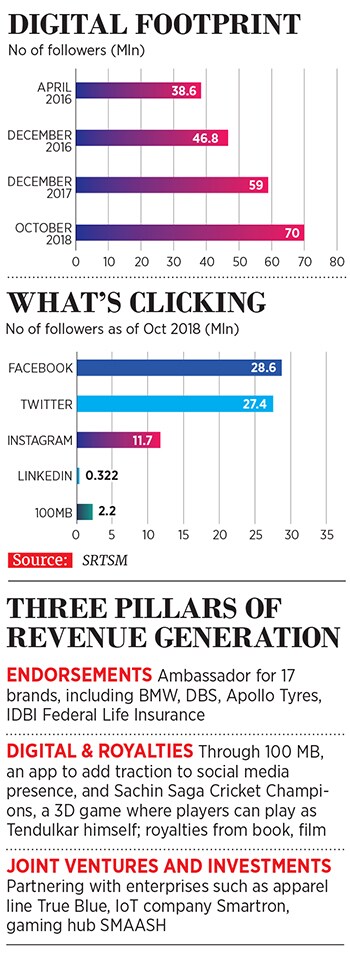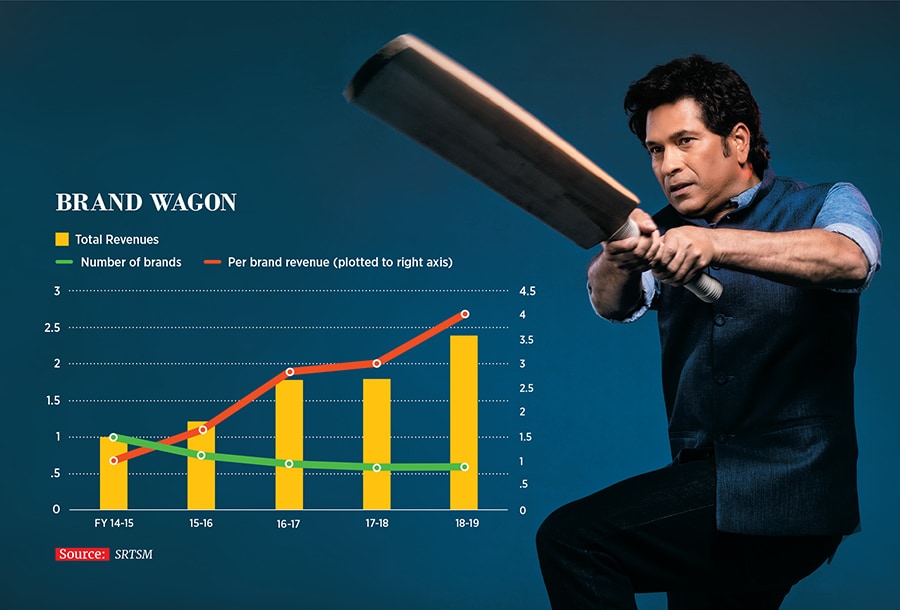Second innings: Sachin Tendulkar gets into his stride
Leveraging on his personal values as a cricketer, the master blaster continues to flourish as a covetable brand five years after his retirement
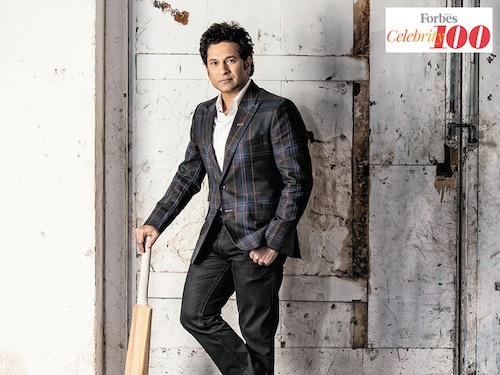

 Forbes India Celebrity 100 Rank No. 9 Wardrobe: True Blue Makeup Artist: Vipul Bhagat Hair: Team Hakim's aalimGive Sachin Tendulkar a bat and you can’t tell that he hasn’t held it for the past five years. At least not in the way we’ve known him to. Even now, as he plays a mock hook for the photographer, he knows precisely when the blade will be low enough to expose his eyes to the camera. “Three, two, one,” he counts down, as he swivels, just like he would have done to Australian pacer Glenn McGrath. The camera shutter might lag for a fraction of a second, but Tendulkar doesn’t. It is enough to know why this 45-year-old owns the benchmarks of cricketing excellence.
Forbes India Celebrity 100 Rank No. 9 Wardrobe: True Blue Makeup Artist: Vipul Bhagat Hair: Team Hakim's aalimGive Sachin Tendulkar a bat and you can’t tell that he hasn’t held it for the past five years. At least not in the way we’ve known him to. Even now, as he plays a mock hook for the photographer, he knows precisely when the blade will be low enough to expose his eyes to the camera. “Three, two, one,” he counts down, as he swivels, just like he would have done to Australian pacer Glenn McGrath. The camera shutter might lag for a fraction of a second, but Tendulkar doesn’t. It is enough to know why this 45-year-old owns the benchmarks of cricketing excellence.
Milestones like a hundred international centuries, the first double century in One Day Internationals (ODIs), and the highest runs in Tests as well as ODIs have given him an equity that is as timeless as Romanian gymnast Nadia Comăneci’s perfect 10 score, and one that extends beyond the boundary lines. Over 24 years, they have chiselled the transformation of a diffident boy-next-door—at 16, he had folded up his first TV interview with Tom Alter with a few one-liners—into Indian sport’s most visible brand.
Through Tendulkar came cricketing perestroika in 1995, when celebrity agent Mark Mascarenhas signed him up for a five-year contract valued at ₹30 crore, making him the world’s richest cricketer. In 2001, as revenues, broadcast fees and player salaries exploded, Mascarenhas amped it up to ₹100 crore. Neither Tendulkar nor Indian cricket has looked back since.
*****
It’s been five years since the Master Blaster’s swansong at Mumbai’s Wankhede. But with earnings of ₹80 crore in 2017-18 from 17 brands, Tendulkar is the only retiree to feature in Forbes India’s Celebrity 100, despite not taking either to commentary, like his peers Sourav Ganguly or VVS Laxman, or coaching, like Rahul Dravid. [Tendulkar is an icon player for Mumbai Indians in the Indian Premier League.] At No 9 on the list, he commands an endorsement fee of around ₹8-10 crore per year for about 2-3 days of engagement, third only to Team India captain Virat Kohli’s and former skipper Mahendra Singh Dhoni’s per day fees of ₹4.5 crore and ₹4 crore, respectively.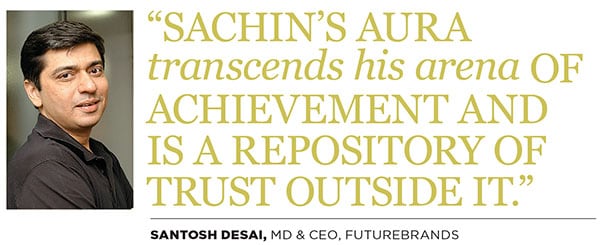
While Kohli’s on-field form since 2016 may have cast a shadow on Tendulkar’s cricketing records, the latter’s retentive aura has elevated him to the stature of a statesman who lends credibility to everything he touches. Santosh Desai, a veteran marketing professional and the MD and CEO of Futurebrands, says, “Sachin’s aura can perhaps be compared to Amitabh Bachchan’s. He isn’t there yet, but represents the same idea of someone who transcends his arena of achievement and becomes a repository of trust outside of it.” Translated to brand endorsements, it embodies a universal appeal cutting across products and target groups.
*****
With reduced proximity to the message that it represents, the value of a brand wanes over time. For Tendulkar, it would mean that his image as a world-beater would weaken with every passing year of his retirement. But, according to data from SRT Sports Management (SRTSM), the company founded by the cricketer and wife Anjali in 2016 to represent him, Tendulkar’s revenues from brand associations are estimated to rise 2.3x in 2018-19, from 2014-15, the year after he retired, despite a dip in the number of endorsements. During this period, his per brand revenue will have quadrupled.
CLICK HERE to view the 2018 Forbes India Celebrity 100 list
“Sachin as a brand will generate value for many decades. He holds so many records that every time a public discourse refers to any of these, his name will appear and earn him a few new followers,” says Arvind Sharma, ex-chairman and CEO, Leo Burnett. “However, beyond records, Sachin’s brand has been rooted in a special bond. He represented the hope of India winning as long as he was on the field. With the Indian team routinely winning in all formats, this bond has been losing its special meaning. If his revenues are going up, I would credit this to smarter management strategies to plug revenue leakage rather than to improving brand equity.” 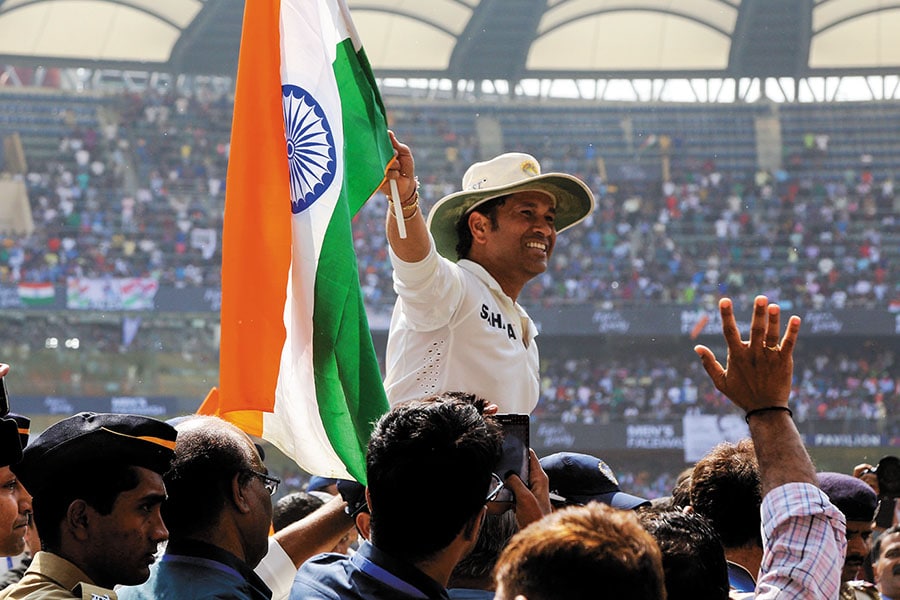 Sachin Tendulkar retired from international cricket in 2013 after playing a record 200 Tests Image: FotocorpIf it is indeed astute management at play, Tendulkar can feel vindicated about setting up SRTSM, bringing together seasoned managers to chart the growth trajectory of his second innings. At a time when he could have continued to be represented by an external agency, he decided to start his own company to transform ‘Brand Sachin’ into ‘Enterprise Sachin’. “While I was playing, I never focussed on anything else. Now that I have some more time, I want to have my own organisation that would reflect my values,” he says.
Sachin Tendulkar retired from international cricket in 2013 after playing a record 200 Tests Image: FotocorpIf it is indeed astute management at play, Tendulkar can feel vindicated about setting up SRTSM, bringing together seasoned managers to chart the growth trajectory of his second innings. At a time when he could have continued to be represented by an external agency, he decided to start his own company to transform ‘Brand Sachin’ into ‘Enterprise Sachin’. “While I was playing, I never focussed on anything else. Now that I have some more time, I want to have my own organisation that would reflect my values,” he says.
While the easy part was doing the maths of whether to pay a percentage of his income as commission to an agency or channel it towards SRTSM, the tough question was: How do you enhance the value of a brand that is already larger than life? Mrinmoy Mukherjee, a marketing professional with over two decades of experience, was thrown the challenge as he came on board as director and CEO. “Commercially, if you just look at endorsements, you can lock brands for two-, three- or five-year periods. They are finite in nature. If you can create value through building businesses and brands, and ensure cash flows through equity, joint ventures and royalty, you can sustain it over a long time. Rather than look at here-and-now, we decided to explore channels of legacy-creation,” says Mukherjee. Just like basketball legend Michael Jordan did to reportedly earn over $100 million in royalties alone from Nike, nearly 15 years after his retirement.
*****
To ensure continuity between his two innings, the edifice of Tendulkar Inc had to be representative of the values he stood for on the field: Excellence and hard work, yes, but also honesty and transparency, the kind that propelled him to walk off against the West Indies in the 2011 World Cup after the umpire failed to detect an edge caught by the keeper.
World over, such soft values have been the cornerstone of commercial appeal. A case in point would be US golfer Arnold Palmer who, according to Forbes, was the second-highest earning deceased celebrity in 2017, after Michael Jackson, notching $40 million a year after his death. In a survey conducted by E-Poll in 2011, in which athletes and other high-profile individuals were ranked on 46 attributes, being sincere and trustworthy among others, Palmer scored 95, the highest for a golfer, ahead of Jack Nicklaus who won 11 majors more than him.For Tendulkar too, SRTSM benchmarked brands against their commercial potential and values. “We decided to rationalise our portfolio on the key criteria of brand value, social relevance and commercial appeal. Brands would continue to stay basis these,” says Mukherjee. The team decided to go deep instead of wide, with a handful of brands that would give them more salience. Accordingly, Tendulkar’s brand endorsements have reduced to 17 as of October 2018 from a bouquet of 25 two years ago, but his revenue has doubled during this period. “We have seen a 40 to 60 percent year-on-year increase in revenue,” adds Mukherjee.
Even with such a matrix, Tendulkar has an absolute veto over what he associates with. No tobacco, alcohol or gambling endorsements, for instance. “When I started playing, I had promised my father I wouldn’t endorse these, directly or through surrogates. If you remember, in the mid-1990s, two tobacco brands had sponsored bat stickers. The entire team was playing with them, except No 4. I played with a blank blade,” he says. “Around 2010, too, an alcohol company literally offered me a blank cheque and I refused. I hadn’t done it then, and I still won’t do it.”
Mukherjee reveals that during their initial strategy planning meetings, Tendulkar made it clear that his portfolio had to deliver value socially. That resulted in partnerships with the government on key initiatives, such as Swachh Bharat, Skill India and road safety, and extending his association with Unicef (which started in 2003) he has backed Unicef’s polio prevention programmes and hygiene and sanitation campaigns for children, has been appointed the UN ambassador for South Asia, and the Unicef and ICC Cricket for Good ambassador for the Women’s World Cup. These enabled advocacy on issues that he held dear: Healthy living for kids and the propagation of sports among women.
“His involvement has never been on a one-ad or one-engagement basis,” says a Unicef representative. “He was always genuinely interested. Whether that meant asking relevant questions to understand the efficacy of our campaigns or driving to Ratnagiri to hold a handwash awareness session at a school for visually-impaired kids.”
“If you look at many of his brand endorsements,” says Prakash Iyer, former MD, Kimberly Clark, and author and leadership coach, “Sachin has turned them into social messages. He’s taken the right strategy here. We don’t dissociate brands from our experience with them. On the field he was seen as a selfless performer, so if he can associate himself with larger causes, it bridges the gap that time creates.”
*****
The key quest for every brand is to anticipate the future audience and stay agile for them. Brand Tendulkar, too, wanted to be identified with emerging values resonant with Gen Z and beyond. He found his sweet spot with fitness and health. It was the subject of Tendulkar’s only Rajya Sabha speech—he was a nominated Member of Parliament—on December 21 last year, which was disrupted by Congress MPs protesting against Prime Minister Narendra Modi. The House was adjourned, but Tendulkar posted his speech on social media to convey his concerns about how non-communicable diseases were going to cost India about $6.3 trillion between 2012 and 2030.
One of his portfolio picks was IDBI Federal Life Insurance, which, instead of instilling the fear of death and financial insecurity, invoked a message of health and wellness by sponsoring marathons in Mumbai, Kolkata, Delhi and Kochi, four of its top markets. Since 2016, Tendulkar has been an ambassador for the marathons, flagging them off as early as 4.30 am, and staying on for prize distributions in pouring rain, like for the Mumbai half marathon in August 2017. This October, the company expanded his role and signed him on as an ambassador for the entire brand. “Our marketing needle has moved since roping in Tendulkar,” says Vighnesh Shahane, CEO and wholetime director of IDBI Federal Life Insurance.
Tendulkar’s choice of signing up for Apollo Tyres a few months ago, despite his association with rivals MRF for many years during his playing days, also hinges around the philosophy of creating a lasting influence. Its tagline ‘Going The Distance’ is in sync with his brand vision and, as an Indian multinational, the company represents what Tendulkar stood for. “When we look at Sachin, he is not just a cricketer, but a sporting icon. He still inspires Indians. His premium positioning and global journey are similar with Apollo’s. His image is sticky, and appeal ageless,” says Satish Sharma, president, Asia Pacific, Middle East and Africa region, for Apollo Tyres.
Vipul Sabharwal, managing director, Luminous Power Technologies, agrees. “Luminous took on Sachin as a brand ambassador in 2010 and we have extended our association to 2024. What he is today is a sum total of his 24 playing years, plus exemplary conduct after it. Has any Indian sportsman ever stayed relevant for as long as Sachin?” he asks.The future of branding lies in the digital space, in its social and participatory prowess, and it’s an aspect even cricketing gods can’t turn a blind eye to. Besides endorsements, SRTSM has had to rewire its strategy to focus on digital platforms as a second stream of revenues. Part of building a captive audience comes from SRTSM’s 51:49 joint venture with JetSynthesys, a digital entertainment and gaming company, to develop 100 MB, an online platform that aggregates multi-format content like chats, quizzes, and auction of personalised merchandise. Launched in March 2017, it recently broadened its horizon to include other cricketers such as Mithali Raj, Ganguly, Colin Munro and Ish Sodhi. “At this point, it’s a 2.2-million community, which we are looking to grow to 5 million,” says Rajan Navani, its vice chairman and managing director.
Tendulkar’s digital footprint, meanwhile, has doubled in the last two years with a current combined following of over 70 million across Facebook, Twitter, Instagram, LinkedIn and 100 MB, up from 38.6 million in April 2016. Team SRTSM: (Standing from left) Rajyalakshmi Gummadi, VP, brand development Mrinmoy Mukherjee, director & CEO Zoya Kazani, manager, corporate & social initiatives June Fernandes, head, office administration and executive secretary Minu Vaidya, head, compliance & accounts (Seated from left) Saurabh Saboo, VP, finance & strategy Anjali Tendulkar, co-founder, and Sachin Tendulkar
Team SRTSM: (Standing from left) Rajyalakshmi Gummadi, VP, brand development Mrinmoy Mukherjee, director & CEO Zoya Kazani, manager, corporate & social initiatives June Fernandes, head, office administration and executive secretary Minu Vaidya, head, compliance & accounts (Seated from left) Saurabh Saboo, VP, finance & strategy Anjali Tendulkar, co-founder, and Sachin Tendulkar
Image: Mexy XavierBut digital engagement may be a tricky terrain for a cricketer who belongs to a generation not entirely comfortable with social media, which digs those with a natural temperament of visibility. And Tendulkar is no Virender Sehwag, who can ramp up digital presence through a Twitter duel with British journalist Piers Morgan. This is where second-hand interactions help in building a legacy. To that end, JetSynthesys is developing the Sachin Saga Cricket Champions, a free 3D game where gamers can play as the legend in virtual reality. With high-end graphics and animations derived from flying down Tendulkar to the UK and motion capturing his shots, Sachin Saga has about 7.2 million downloads since its launch in December 2017.
*****
Another prong of Tendulkar’s second-innings strategy is entrepreneurial forays, through equity investments and joint ventures. How does he pick his horses? Values, of course, and instinct. Even during his playing days, Tendulkar claims to have had an intuition about how brands should connect with people.
Remember that Pepsi ad during the 1999 World Cup in which actor Shah Rukh Khan disguises himself as Tendulkar to enter the dressing room, only to be told by then captain Mohammad Azharuddin, “Pad up, you are on?” As Khan totters towards the ground with a bat and a can of Pepsi in hand, the real Sachin catches him at the entrance and assures him that he will take it from there. “As per the original script, I was to take the bat and head out, while Shah Rukh would go back into the dressing room. But I suggested that the ad makers could add a spin by sending Sachin inside with the can of Pepsi, and Shah Rukh out to bat, since the fight was over Pepsi and not who would bat. They liked it, changed the script and that’s how it was aired,” recalls Tendulkar.
He must have had a similar finger on the pulse when, in 2015, he got into a business partnership with Smartron, a Hyderabad-based company founded by Mahesh Lingareddy that deals with the Internet of Things, and builds smart gadgets for everyday use. Tendulkar has a 5.5 percent stake in it, according to data from Tracxn. Or when he backed a 23-year-old Anjana Reddy in 2012, when the Deccan Chronicle scion launched Universal Sportsbiz Private Limited, which sold sports memorabilia and autographed merchandise. He stayed invested even as the company pivoted to fashion clothing end-2013, and started selling Kohli’s Wrogn in February 2015. As of October 2018, Tendulkar has a 7.2 percent stake in the company (Tracxn data) that has recently raised about ₹100 crore in Series E funding and is valued at ₹1,200 crore.
But despite Tendulkar’s endorsements and engagements as a cricketer, entrepreneurship is a new game. Does he have it in him to hit it out of the park here as well? “Today, brands are built on authenticity. The core need is not to sell a product but a story. Marketing is being replaced by nuanced engagement. You won’t find a brand more authentic than Sachin Tendulkar,” says Kulin Lalbhai, executive director of textile manufacturer Arvind Ltd, with whom Tendulkar has a joint venture apparel line called True Blue.
*****
Will Tendulkar’s statesman-like stature be as compelling to a generation that won’t see him play? Will Kohli snaffle the legend of Sachin with his era-defining success? The debate is on. But, while, like every generation, this one too is inching towards claiming Kohli as the greatest ever, the 30-year-old’s biggest test will be to surpass the longevity of Tendulkar’s career and the weight of his records, even if he eclipses them, says sports writer Sharda Ugra.
And the values he stood for, adds Richard Goatley, CEO of Middlesex County Club, which has tied up with Tendulkar to roll out the Tendulkar Middlesex Global Academy (TMGA), in which the cricketer and coaches of the British club have drawn up a curriculum. “His values of playing with honesty and integrity go far beyond just being a good batsman or bowler. They will continue to stay relevant because they outlive the cut-throat aspects of life,” says Goatley.
What will benefit Tendulkar’s persona to a certain extent is the way his doughty spirit was housed in a polite and almost-unassuming exterior, far from the flashy and in-your-face personalities that contemporary cricket has come to be associated with. During his playing days, Tendulkar barely ever took a misstep or spoke out of turn and while his reticence over key issues, like match-fixing, has sometimes come in for criticism, it’s also true that he comes from a pre-digital socio-cultural milieu where barely any Indian athlete took a public stand.
“Besides,” says Desai of Futurebrands, “there are brand ambassadors who get chosen because of a specific type of personality, and some others because of the absence of it. Sachin and Jordan fall in the latter category. These are also the kind of brands that have a greater longevity because you can throw them into any mix without altering their fundamental character.”
However, the danger with such personalities lies in indiscriminately accepting brand associations, once they hang up their boots, to remain visible. And the real temptation is to go down the food chain and continue to generate money. “The best thing would be to approach the coming decades with grace instead of peddling your old achievements. And that’s exactly what Sachin is doing: By not telling the world that he was a hero, and not doing too many things to hold on to his power,” adds Iyer.
But most important is to accept that, beyond a point, you can’t do much to bump up your equity. That, just like Kapil Dev and Sunil Gavaskar, arguably Indian cricket’s greatest heroes before him, Tendulkar too will one day become a celebrity that was. “There is nothing that Sachin can do today that will be construed a bigger achievement than what he did during his playing days. That’s true and that’s life,” says Desai.
But, like the eternal optimist that he claims he is, Tendulkar isn’t thinking that far: “The current generation remembers me because they saw me play. It took me around 30 years to build up that reputation. I am merely into the fifth year of my second innings. Hopefully, you and I will be sitting across this table 25 years on and judging this.”
First Published: Dec 05, 2018, 05:50
Subscribe Now